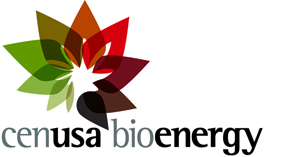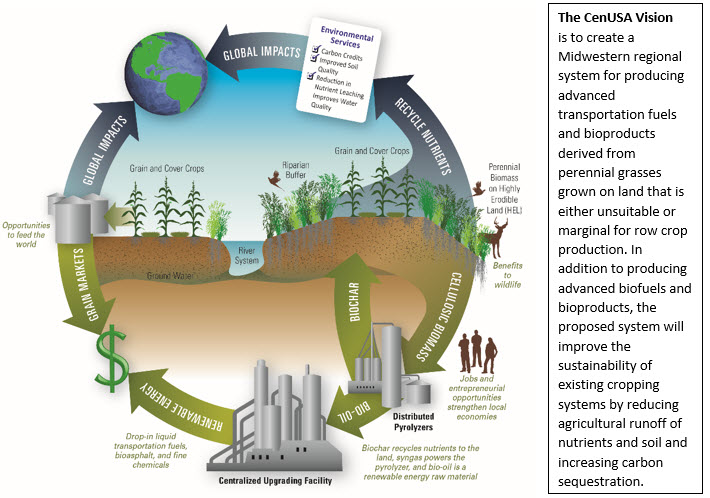Sponsoring Partner

Funded by AFRI. Learn More.
CenUSA Feedstock Development Team identifies gene pools and genetic diversity for improved switchgrass varieties and increased yields.
Table of Contents
- Team Objectives
- The Team and Collaborators
- Team Activities
- Outcomes from The Team’s Work
- Why This Work Is Important
- Contributors to This Report
- CenUSA Feedstock Development Team Publications

Team Objectives
The objective of the CenUSA Feedstock Development team is to develop new and improved perennial grass varieties and hybrids that can be used on marginal cropland in the Central United States for the production of biomass for bioenergy and bioproducts.
The Team and Collaborators
The team’s Project Directors are Mike Casler, Plant Breeder at the U.S. Dairy Forage Research Center and Rob Mitchell, Research Agronomist at the USDA Agricultural Research Service (ARS).
Team Collaborators provided expertise across a number of disciplines: Bruce Dien, bioenergy researcher and chemical engineer at the USDA-ARS; Gary Yuen, plant pathologist at the University of Nebraska – Lincoln; Tiffany Heng-Moss, entomologist at the University of Nebraska – Lincoln; Akwasi Boateng, chemical engineer specializing in biofuels, USDA-ARS; and Ken Moore, agronomist at Iowa State University.
Team Activities
The CenUSA’s Feedstock Development team worked on developing new switchgrass varieties and ways to produce more biomass with the goal of doubling switchgrass yields by 2020, primarily through boosting the rate of annual gain. The team’s efforts focused on switchgrass, a perennial warm-season grass native to most of North America, because of its potential for high yields on marginal cropland and adaptation to a wide range of habitats and climates.
By employing new methods such as hybridization, delayed flowering, and genomics, the team worked to generate new switchgrass varieties for both bioenergy and forage that are more vigorous and better adapted to marginal lands. They also studied how to better manage switchgrass plants.
Researchers and graduate students scoured fields and prairies for switchgrass plants of many varieties. They brought hundreds of leaf or seed samples back to their laboratories and then spent even more hours in the lab, studying and sequencing plant DNA. Other team members sampled switchgrass plants to discover how they are threatened by insects and diseases.
Outcomes from The Team’s Work
The team’s achievements ranged widely. Researchers:
- Created Liberty, a new switchgrass variety that yields 40% more than other varieties and is widely adapted throughout the Midwest. Plant breeders combined yield traits from southern lowland types with winterhardiness of northern upland types to create Liberty.
- Developed a system for classifying gene pools of switchgrass that could provide germplasm for improvement of varieties for biofuels and ecosystems services.
- Identified eight gene pools of switchgrass across the United States that could be a rich source of germplasm to improve commercial switchgrass varieties for biofuel production, and in restoration and conservation work. These gene pools harbor a great deal of genetic variety, providing a potential source of improved germplasm for new varieties that can respond better to climate change. Identification of gene pools gives plant breeders more information, leading to development of a wider range of varieties, adapted to specific regions, for producers to choose from.
- Identified the origins and the genetic diversity of the two switchgrass ecotypes, upland and lowland, in their native habitats. Because the two ecotypes are adapted to different environments, that identification is important in the classification of gene pools.
- Identified potential pests of switchgrass. Entomologists found that insects such as aphids could threaten switchgrass production for biofuels. They found that some varieties have resistance to these pests, information important in the development of new varieties. A significant question for researchers to answer in the future: how will manipulating switchgrass varieties to improve them affect their resistance to pests?
- Identified the Panicum mosaic virus as a significant pathogen that could stymie production of switchgrass for biofuels. Geneticists are studying the plant’s response to this and other pathogens. Results will help pathologists make recommendations on preventing and managing diseases in switchgrass.
- Developed a method of NIR calibration to measure more plant properties in switchgrass. This will be valuable in breeding improved bioenergy crop lines and will eventually be used by commercial biorefiners in thermochemical and biochemical conversion processes.
Knowledge of composition directly affects product conversion yields and reaction conditions for optimal processing. A rapid and inexpensive method for analyzing chemical composition of switchgrass and other warm-season grasses will enable effective plant breeding of better bioenergy crop lines, and is now being adopted by other perennial grass researchers. It will also help commercial biorefiners to efficiently and accurately grade biomass delivered at the factory gate.
Why This Work Is Important
The work of CenUSA’s Feedstock Development Team is a cornerstone in the creation of a flourishing biofuels industry. It is valuable to perennial-grass producers, to processors and refineries, and to geneticists and plant breeders who will create the varieties of the future.
By identifying and classifying switchgrass gene pools, then employing them to develop new varieties, the team opens up more possibilities for successful switchgrass production. For example, introduction of the new variety, ‘Liberty,’ gives potential producers in the Midwest an excellent choice that is well adapted to their area, so they have a greater opportunity for success.
Plant breeders are providing important new information for the successful management of switchgrass.
These findings provide a foundation for continued work into the future, including:
- Developing more varieties, better adapted to marginal lands, later flowering, and higher yielding.
- Employing new genomic technologies to accelerate development of new varieties and genetically modified switchgrass, and to improve winter survival in southern types of switchgrass.
- Developing more efficient fermentation of biomass, a plus for producing either animal products from forage or liquid fuels from biomass.
- Improving the plant’s capacity to recycle more nitrogen (N) back into its roots before it is harvested, so growers need apply less N fertilizer.
Contributors to This Report
Authors:
- Michael D. Casler, USDA-ARS, U.S. Dairy Forage Research Center
- Susan J. Harlow, Freelance Journalist
CenUSA Feedstock Development Team Publications
Fact Sheets
- Switchgrass (Panicum virgatum) for Biofuel Production – Rob Mitchell, USDA-ARS (related PDF handout)
- Plant Breeders Create New and Better Switchgrass Varieties for Biofuels– Michael Casler, USDA-ARS
Research Summaries
- Near-Infrared (NIR) Analysis Provides Efficient Evaluation of Biomass Samples – Bruce Dien, USDA-ARS
- Research Finds Strong Genetic Diversity in Switchgrass Gene Pools – Michael Casler
Webinars
- Switchgrass and Perennial Grasses, Biomass and Biofuels – Part 1 – Ken Vogel, USDA-ARS
- Switchgrass and Perennial Grasses, Biomass and Biofuels- Part 2 – Ken Vogel, USDA-ARS
- Switchgrass Production Industry Perspectives – David Stock, Stock Seed Farms
- Diversifying Cellulosic Feedstocks – DK Lee
- Aphid Resistance in Switchgrass CenUSA Bioenergy – Kyle Koch
Instructional Video
- Plant Breeding to Improve Yield and Sustainability of Perennial Grasses – Michael Casler
- Plant Pathogen Risk Analysis for Bioenergy Switchgrass Grown in the Central USA – Gary Yuen
- Entomology Research: Examining Insect Populations and Exploring Natural Plant Resistance (Captions) – Tiffany Heng-Moss
FAQs (Frequently Asked Questions)
- Why is it important to be able to grow a consistent and uniform supply of a biomass feedstock?
- Should I begin establishing switchgrass in case they put a cellulosic ethanol plant near by?
Journal Publications
- Casler, M.D. (2014). Heterosis and reciprocal-cross effects in tetraploid switchgrass. Crop Sci. 54(5): 2063 . DOI: 10.2135/cropsci2013.12.0821.
- Casler, M.D. & Vogel, K.P. (2014). Selection for biomass yield in upland, lowland, and hybrid switchgrass. Crop Sci. 54(2):626-636. DOI: 10.2135/cropsci2013.04.0239.
- Dien, B. S., P.J. O’Bryan, R.E. Hector, L.B. Iten, R.B. Mitchell, N. Qureshi, S. Gautum, K.P. Vogel, & M.A. Cotta. 2013. Conversion of switchgrass to ethanol using dilute ammonium hydroxide pretreatment: influence of ecotype and harvest maturity. Environ. Technol. 34:13-14. DOI: 10.1080/09593330.2013.833640
- Feng, Q., I. Chaubey, G.Y. Her, R. Cibin, B. Engel, J.J. Volenec & X. Wang. 2015. Hydrologic and water quality impacts and biomass production potential on marginal land. Environmental Modelling & Software. 72:230-238. http://dx.doi.org/10.1016/j.envsoft.2015.07.004
- Jahufer, M.Z.Z. & M.D. Casler. 2014. Application of the Smith-Hazel selection index for improving biomass yield and quality of switchgrass. Crop Sci. 55(3):1212. doi: 10.2135/cropsci2014.08.0575.
- Koch, K., R. Fithian, T. Heng-Moss, J. Bradshaw, J., G. Sarath, & C. Spilker. (2014). Evaluation of tetraploid switchgrass populations (Panicum virgatum L.) for host suitability and differential resistance to four cereal aphids. J. Econ. Entomol. 107(1):424-431. 2014. DOI: http://dx.doi.org/10.1603/EC13315
- Koch, K., T. Heng-Moss, J. Bradshaw & G. Sarath, G. (2014). Categories of resistance to greenbug and yellow sugarcane aphid (Homoptera: Aphididae) in three tetraploid switchgrass populations. Bioenerg. Res. 7:909-918. DOI: 10.1007/s12155-014-9420-1
- Koch, K., N. Palmer, M. Stamm, J. Bradshaw, E. Blankenship, L. Baird, G. Sarath, and T. Heng-Moss. 2014. Characterization of Greenbug Feeding Behavior and Aphid (Hemiptera: Aphididae) Host Preference in Relation to Resistant and Susceptible Tetraploid Switchgrass Populations. Bioenergy Research 8: 165-174.
- Nichols, V.A., F.E. Miguez, M.E. Jarchow, M.Z. Liebman & B.S. Dien 2014. Comparison of cellulosic ethanol yields from midwestern maize and reconstructed tallgrass prairie systems managed for bioenergy. Bioenerg. Res. 7: 1550. doi: 10.1007/s12155-014-9494-9
- Price, D.L. & M.D. Casler (2014). Divergent selection for secondary traits in upland tetraploid switchgrass and effects on sward biomass yield. BioEnergy Res. 7(1):329-337. doi: 10.1007/s12155-013-9374-8
- Price, D.L. & M.D. Casler. (2014). Inheritance of secondary morphological traits for among-and-within-family selection in upland tetraploid switchgrass. Crop Sci. 54:646-653. doi: 10.2135/cropsci2013.04.0273
- Price, D.L. & M.D. Casler. (2014). Predictive relationships between plant morphological traits and biomass yield of switchgrass. Crop Sci. 54(2):637-645. doi: 10.2135/cropsci2013.04.0272
- Ramstein, G.P., J. Evans S.M. Kaeppler, R.B. Mitchell, K.P. Vogel, C.R. Buell & M.D. Casler. 2015. Accuracy of genomic prediction in switchgrass improved by accounting for linkage disequilibrium. G3: Genes, Genomes, Genet. 6(4):1049-1062. doi: 10.1534/g3.115.024950. http://g3journal.org/content/6/4/1049.full
- Resende, R.M.S., de Resende, M.D.V. & Casler, M.D. (2013). Selection methods in forage breeding: a quantitative appraisal. Crop Sci. 53:1925-1936.
- Resende, R.M.S., Casler, M.D., & de Resende, M.D.V. (2014). Genomic selection in forage breeding: Accuracy and methods. Crop Sci. 54:143-156.
- Schaeffer, S., F. Baxendale, T. Heng-Moss, R. Sitz, G. Sarath, R. Mitchell, & R. Shearman. 2011. Characterization of the arthropod community associated with switchgrass Poales: Poaceae in Nebraska. J. Kans. Entomol. Soc. 84(2): 87-104. https://naldc.nal.usda.gov/download/54245/PDF
- Serapiglia, M.J., A.A. Boateng, D.K. Lee & M.D. Casler. (2016). Switchgrass harvest time management can impact biomass yield and nutrient content. Crop Sci. 56(4):1970-1980. doi: 10.2135/cropsci2015.08.0527
- Serapiglia, M.J., B. Dien, A.A. Boateng & M.D. Casler. 2016. Impact of harvest time and switchgrass cultivar on sugar release through enzymatic hydrolysis. BioEnergy Res. DOI: 10.1007/s12155-016-9803-6
- Serapiglia, M.J., C.A. Mullen, A.A. Boateng, B. Dien & M.D. Casler. 2016. Impact of harvest time and cultivar on conversion of switchgrass to fast pyrolysis bio-oils. BioEnergy Res. (In review).
- Slininger, P.J., B.S. Dien, C.P. Kurtzman, B.R. Moser, E.L. Bakota, S.R. Thompson, P.J. O’Bryan, M.A. Cotta, V. Balan, M. Jin, M.D. Sousa & B.E. Dale. 2016. Comparative lipid production by oleaginous yeasts in hydrolyzates of lignocellulosic biomass and process strategy for high titers. Biotechnol. Bioeng. 113: 1676–1690. doi: 10.1002/bit.25928
- Stewart C.L., J.D. Pyle, K.P. Vogel, G.Y. Yuen & K.G. Scholthof. 2015. Multi-year pathogen survey of biofuel switchgrass breeding plots reveals high prevalence of infections by Panicum mosaic virus and its satellite virus. Phytopathology 105:1146-1154. doi:10.1094/PHYTO-03-15-0062-R
- Vogel, K.P., G. Sarath & R.B. Mitchell. 2014. Micromesh fabric pollination bags for switchgrass. Crop Sci. 54(4): 1621-1623. doi: 10.2135/cropsci2013.09.0647
- Vogel, K.P., Mitchell, R.B., Casler, M.D. & G. Sarath. (2014). Registration of ‘Liberty’ switchgrass. J. Plant Registration 8:242–247. DOI: 10.3198/jpr2013.12.0076crc.
- CenUSA Project Resources – information on the opportunities and challenges in developing a sustainable system for the thermochemical production of biofuels from perennial grasses grown on land marginal for row crop production.
CenUSA Bioenergy is a coordinated research and education effort investigating the creation of a regional system in the Central US for producing advanced transportation fuels from perennial grasses on land that is either unsuitable or marginal for row crop production.* In addition to producing advanced biofuels, the proposed system will improve the sustainability of existing cropping systems by reducing agricultural runoff of nutrients in soil and increasing carbon sequestration.
CenUSA is supported by Agriculture and Food Research Initiative Competitive Grant no. 2011-68005-30411 from the USDA National Institute of Food and Agriculture.

